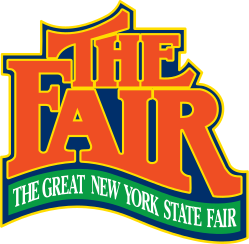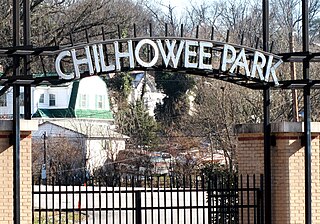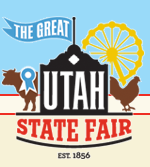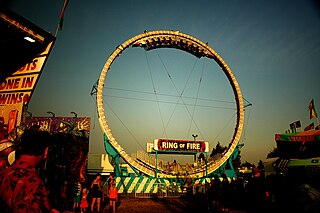
East Tennessee is one of the three Grand Divisions of Tennessee defined in state law. Geographically and socioculturally distinct, it comprises approximately the eastern third of the U.S. state of Tennessee. East Tennessee consists of 33 counties, 30 located within the Eastern Time Zone and three counties in the Central Time Zone, namely Bledsoe, Cumberland, and Marion. East Tennessee is entirely located within the Appalachian Mountains, although the landforms range from densely forested 6,000-foot (1,800 m) mountains to broad river valleys. The region contains the major cities of Knoxville and Chattanooga, Tennessee's third and fourth largest cities, respectively, and the Tri-Cities, the state's sixth largest population center.


The New York State Fair, also known as the Great New York State Fair, is a 13-day showcase of agriculture, entertainment, education, and technology. With midway rides, concessionaires, exhibits, and concerts, it has become New York's largest annual event and an end-of-summer tradition for hundreds of thousands of families from all corners of the state. The first fair took place in Syracuse in 1841, and took permanent residence there in 1890. It is the oldest and one of the largest state fairs in the United States, with over one million visitors annually.

Lane County Fair is a fair that is held in the middle of the summer every year, at Eugene, Oregon, and it features cuisine, entertainment, and music. Excellent family entertainment, cuisine, and artwork can be found at the Lane County Fair. A Lane County Agricultural Society was established in 1858, and on October 9, it hosted its inaugural show, which was still not regarded as fair. In 1860, a state agricultural association was established, and it was planned to host a state fair. From October 3 to October 4, 1860, a state fair was conducted close to Oregon City. On October 9 and 10, 1861, there was another fair. Finally, the inaugural "Lane County Fair" was held for three days on September 25, 1884. Excellent family entertainment is available at the Lane County Fair, including performances, rides, games, and fun. Examine the arts and crafts, agricultural, and animal exhibits in the exhibition hall. Enjoy the fair classics like cotton candy, elephant ears, BBQ, and ice cream from your favorite food vendors. There will be a big Ferris wheel at the fair that will allow you to see Eugene and the fairgrounds from above. horses, cattle, sheep, goats, rabbits, and poultry will be presented and evaluated for both adult and juvenile competition.

The Harford Fair is a fair held in Harford Township north of Scranton in Susquehanna County, Pennsylvania. It is a traditional country fair that features amusement rides. It also includes livestock judging, chainsaw races, tractor pulls, draft horse and other animal shows. It also includes two selected annual events, such as monster trucks.

Chilhowee Park is a public park, fairgrounds and exhibition venue in Knoxville, Tennessee, United States, located off Magnolia Avenue in East Knoxville. Developed in the late 19th century, the park is home to the Tennessee Valley Fair and hosts several dozen expositions annually. The park covers 81 acres (33 ha), and includes a 57,100-square-foot (5,300 m2) exposition center, a 1910-era bandstand, a 4,500-seat amphitheater, and a 3-acre (1.2 ha) lake, Lake Ottosee. The park is also home to The Muse Knoxville, a children's science museum formerly known as the East Tennessee Discovery Center.

The Hants County Exhibition is an annual fall fair held in Windsor, Nova Scotia. It is known for being the oldest continuously run agricultural fair in North America. It was first held on the grounds of Fort Edward beginning in 1765 and has been running continuously since 1815.The fair has been held at the nearby Hants Exhibition Arena and exhibition grounds since the land was purchased in 1949. September 2015 marked the 250th anniversary of the Hants County Exhibition. Five years later, the fair went virtual because of the COVID-19 pandemic in Canada.

The Eastern Idaho State Fair is an American state fair held annually the first week of September in Blackfoot, Idaho. It is one of three annual state fairs in Idaho; the others being the Western Idaho Fair, which is held in Boise, the state capital, and the Northern Idaho State fair, held in Coeur d’Alene. The gates to the fairgrounds open on Labor Day weekend, the first week in September.

The National Conservation Exposition was an exposition held in Knoxville, Tennessee, United States, between September 1, 1913, and November 1, 1913. The exposition celebrated the cause of bringing national attention to conservation activities, especially in the Southeastern United States. The fair was held in what is now Knoxville's Chilhowee Park in East Knoxville.

Enoch Lloyd Branson (1853–1925) was an American artist best known for his portraits of Southern politicians and depictions of early East Tennessee history. One of the most influential figures in Knoxville's early art circles, Branson received training at the National Academy of Design in the 1870s and subsequently toured the great art centers of Europe. After returning to Knoxville, he operated a portrait shop with photographer Frank McCrary. He was a mentor to fellow Knoxville artist Catherine Wiley, and is credited with discovering twentieth-century modernist Beauford Delaney.

Chilhowee Park is a residential neighborhood in Knoxville, Tennessee, United States, located off Magnolia Avenue in the East Knoxville area. Developed as a streetcar suburb in the 1890s, this neighborhood was initially part of Park City, which was incorporated as a separate city in 1907, and annexed by Knoxville in 1917. Chilhowee Park lies adjacent to one of Knoxville's largest municipal parks, as well as Zoo Knoxville. The neighborhood contains a notable number of early-20th-century houses.
The Rockingham County Fair has been dubbed by the Los Angeles Times as one of the best rural county fairs in the United States for the usual showcases that include: tractor pulls, a demolition derby, amusement rides, an antique auto show, a flea market, and country-western concerts. Local specialties brought to the fair are quince and crab apple jellies, gingerbread, peanut brittle, canned huckleberries and sauerkraut.
Richard Franklin Graf (1863–1940) was an American architect active primarily in Knoxville, Tennessee and the vicinity in the early 20th century. His works include Stratford Mansion (1910), Sterchi Building (1921), St. John's Lutheran Church (1913), and the Journal Arcade (1924). His home, the Prairie School-inspired Graf House, is considered Knoxville's first modern home. Several buildings designed by Graf have been listed on the National Register of Historic Places.

The History of Knoxville, Tennessee, began with the establishment of James White's Fort on the Trans-Appalachian frontier in 1786. The fort was chosen as the capital of the Southwest Territory in 1790, and the city, named for Secretary of War Henry Knox, was platted the following year. Knoxville became the first capital of the State of Tennessee in 1796, and grew steadily during the early 19th century as a way station for westward-bound migrants and as a commercial center for nearby mountain communities. The arrival of the railroad in the 1850s led to a boom in the city's population and commercial activity.


The Appalachian Exposition, also known as the Appalachian Exhibition, was an event held in 1910 and 1911 in Knoxville, Tennessee's on property owned by Knoxville Railway and Light. The park grounds were 65 acres and included two lakes. The exhibitions demonstrated progress in Southern industry. Former president Theodore Roosevelt spoke at the 1910 exposition, and president William Howard Taft spoke in 1911.
















